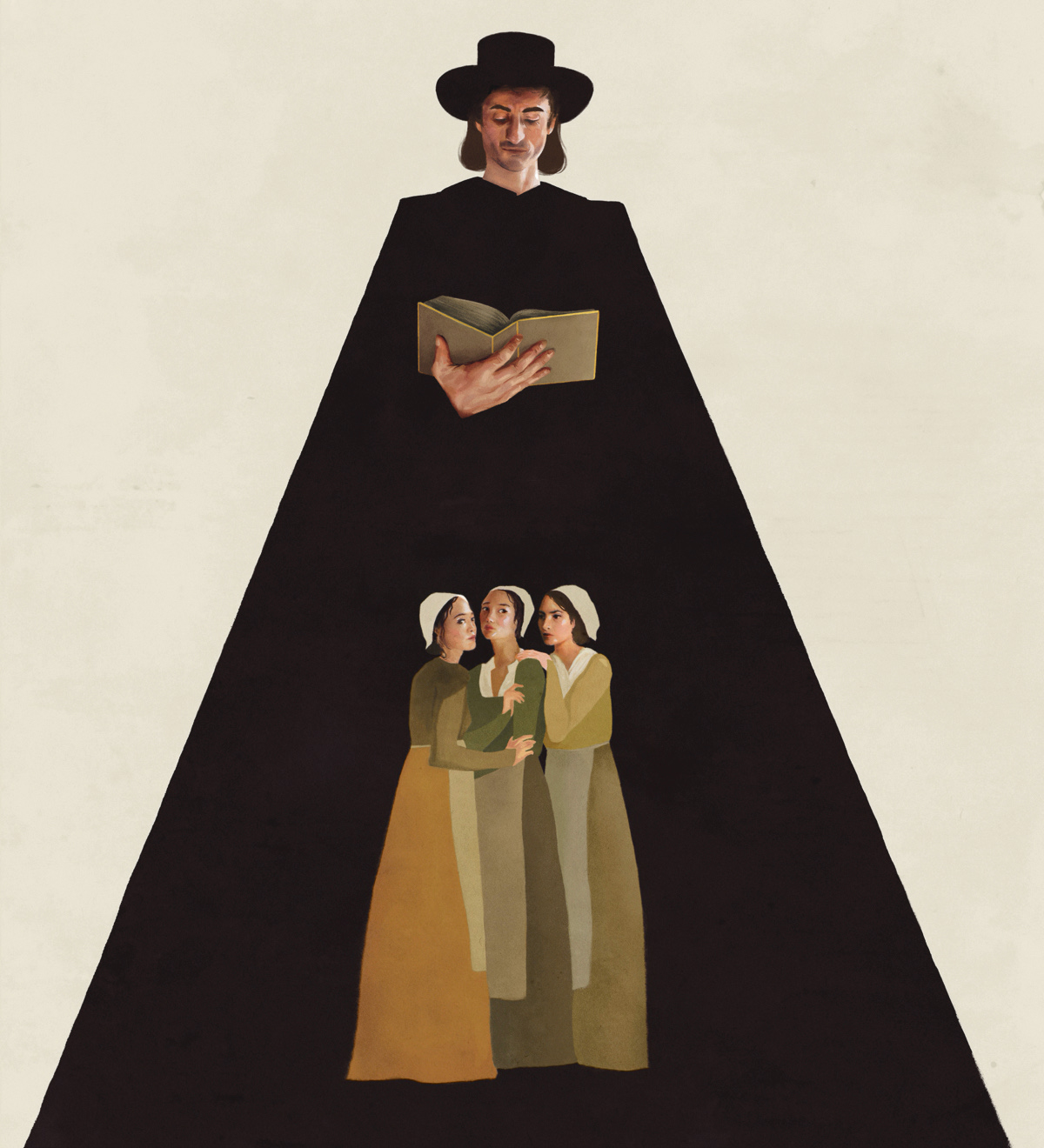Listen to an audio version of this story
For more audio from The Walrus, subscribe to AMI-audio podcasts on iTunes.
For a couple of years around 2000, I lived in Mistley, a pretty village just outside Manningtree, one of England’s smallest towns. Famous for its swans and its pair of elegant eighteenth-century towers, Mistley sits on the Stour Estuary, about an hour’s train ride east of London. My British partner and I lived in a semidetached place in a row of houses at the top of a hill, which petered out into fields. Our next-door neighbour operated a home hair salon, and one weekend she painted her half of the house ivory, so our side looked like a dirty face.
I often thought my own face might be dirty given how I seemed to perplex people in the streets or the shop. I knew I was a complete outsider with my Canadian accent and my jogging. Someone once opened his door to ask what I was running for, and it took me months to learn that “Yallright” was a greeting, not a question. The swans were ruthless and terrifying, chasing me whenever I passed with a bag of groceries. When I ran near Mistley Heath, a wolfhound sometimes appeared out of the woods to chase me too, nipping at my legs. I walked down the hill to Manningtree most mornings and often saw a man in a grey overcoat following me. A low-level paranoia grew in me: Was I literally being chased out?
I found out later that Matthew Hopkins, the self-styled “Witchfinder General” of the 1640s, was buried somewhere behind our house; his grave and most of the adjacent church were lost to trees and grass. He’d conducted interrogations at a nearby inn, sending some 100 people to be hanged for allegedly consorting with the devil. Once I knew that, I wondered whether the presence of his bones might have had some effect on me. I could never get warm in the house although it was well heated and not old for England. I wondered sometimes if it was mildly haunted. I had a hard time sleeping. Was I the problem? Or was my suspicion the problem?
I’ve been reminded of my life in Mistley during the pandemic—the slow-rising fear, the mistrust of others, the general bafflement. Even after lockdowns began to end last year, I spent most of my time holed up inside my home in British Columbia. I insulated myself with old BBC detective shows, and my reading gravitated toward the criminal too. True crime felt too hard to take, so I stuck to fiction, mainly mysteries that felt more solvable than the present. Checking out new-books lists in hopes of anything to take me away, I noticed a thread of literary novels about witches. Witch hunts are detective stories of a kind—as readers parse notions of reality and supposition—which was probably what grabbed me first, but these books are very different. Not the witches of fantasy or of children’s lit, the characters of three 2021 novels are victims of historical persecutions in England, America, and Germany. The stories evoke a deep confusion about what’s happening and whether there’s any way to fix it, echoing so many questions of our current moment.
A. K. Blakemore’s The Manningtree Witches depicts Matthew Hopkins himself, but it’s much more intensely focused on some of the women he pursued. A passionately expressive novel with a bold energy, the book is mainly in the voice of one of the teenage girls accused of witchcraft. Rebecca West lives with her odd, “formidable” mother in Manningtree while they try to make ends meet with sewing and laundry. The girl is smart mouthed, adolescent, and alive, her observations of neighbours and nature full of cockeyed detail. (She wouldn’t mind seeing “an imp streaking red across the damp lawn.”) She has a crush on the clerk who tutors her, and she is too smart for her own good in a small town where the atmosphere is increasingly claustrophobic, with the English Civil War boiling in the background. Matthew, a thin man perpetually dressed all in black, arrives to collect information on suspect happenings—a sickened child, a possible case of possession. Rebecca, who he thinks has “a weird look to her,” is among those rounded up for imprisonment and trial.
These novels are all about rupture and its effects. In The Manningtree Witches, the war is a major split, but gender is another obvious divide. The majority of Matthew’s victims are women, and Rebecca notes wryly, “The men will not save you.” At heart, though, the books are about storytelling itself. Blakemore slyly shows Matthew inventing reasons behind random events and connecting dots to cohere his grand story of evil versus good. He was, after all, a writer too, author of The Discovery of Witches, a kind of how-to guide to hunting them down. But Matthew is a deliberately flattened character: although he often conjures dreamscapes about witch sex, the sections from his perspective are dialled far down compared with those from Rebecca’s. Observing him, Rebecca says, “I can find nothing there.” The book also makes witches into a kind of nothing, just a narrative device: as Rebecca’s mother half-laughs, “Witch is just their nasty word for anyone who makes things happen, who moves the story along.” This story moves along with some shifts and gaps between scenes and includes brief excerpts from real-world trial documents. The structure emphasizes the way we all try to fill in holes however we can. Black rabbits wouldn’t appear around town if there weren’t witches about; cases of the novel coronavirus, some claimed, would spike because of God’s punishment. The subtitle to Matthew Hopkins’s own book is In Answer to Several Queries—he’s just providing the facts behind the question of why the world suffers.
Hopkins’s guide had a large New England fandom, and Chris Bohjalian’s Hour of the Witch takes place in this infamous hunting ground in the mid-1600s. Mary Deerfield has emigrated with her well-off British merchant parents to a purer life in Boston. In this society, talk of the devil is as expected as chat about the weather. Mary marries an older man, Thomas, who proves domineering and abusive, frequently complaining that her brain is made of cheese and that she fails to produce children. Thomas badly injures Mary when he impales her hand with a fork (“the devil’s tines”), and she decides to sue for divorce. Her attempts at freedom, and at healing herself and others, lead only to her being tried for witchcraft. Bohjalian builds another claustrophobic world, and as in The Manningtree Witches, the ridiculousness of the charges creates a disquieting tone. Again, there’s a major split in the community, the “elect” versus the damned, and another between men and women—one of Mary’s crimes is that she speaks “with the surety of a man.”
Bohjalian is excellent at suspense (he also wrote The Flight Attendant) and at lovingly detailed scene setting. Hour of the Witch is more straightforwardly told than The Manningtree Witches, and although its characters are fictional, their quoted testimony is very convincing. But this novel’s true strength is in its portrayal of an abused person’s mind. Mary is not only cut off from others but self-divided too, always wondering if she is good or bad, trying to understand why her husband harms her. The exhaustion of her self-monitoring is painfully realistic. She’s confused over her ability to give herself private sexual pleasure and ashamed that she likes looking at handsome young men.
Hour of the Witch also raises perceptive questions about how fixed identity really is. Fretting over whether she reads too much, as Thomas believes, Mary wonders what it says “about her soul that a few bits of fashionable silk or cotton cloth and some interesting books could make her content.” Even more, the book asks whether we own our identities and whether we can know ourselves, the way many people have questioned who they are in the upheavals of the last two years. David L. V. Bauer, a London virologist who gave a TV news interview on research behind the Pfizer vaccine only to watch anti-vaxers edit, misquote, and circulate it widely online, says he “never imagined that my own work could actually be part of [an anti-vaccine] misinformation arsenal” or that he would be the involuntary star of conspiracy videos that make him out to be either “some sort of supervillain, or the unlikely hero of the anti-vax world.” Mary also speculates whether she might unwittingly be a supervillain herself: “Did a woman who was possessed not know it until it was too late?”
Everyone Knows Your Mother Is a Witch by Rivka Galchen takes the question further. A spiky heroine, Katharina Kepler, mother of scientist Johannes Kepler, is another purported historical witch. As in the other books, there’s turmoil and division, here featuring war and crop failure and Lutherans versus Catholics. In early seventeenth-century Germany, Katharina, a widowed grandmother, irritates many neighbours with her straight talk, her “manly” behaviour, her herbal cures, and her love of her cow. One townsperson, Ursula Reinhold, sets off an avalanche of charges by accusing Katharina of poisoning her with a drink. Others pile on: she caused them bodily harm by looking at them or killed their livestock with a slap or “asked the gravedigger to dig up her father’s skull to make a drinking goblet of it cast in silver—a known witchy tool.”
Galchen’s insightful and dramatic novel is the most absurdist of the three, with the charges against Katharina clearly nonsensical (although based in fact). Its form is also purposely askew, with untitled chapters shifting between Katharina’s voice and her neighbour Simon’s interspersed with courtroom examinations of her neighbours’ accusations. As one witness argues, “We all know she’s a witch. We’ve always known. The matter of how we came to know is simple—we already knew.” How can anyone argue with what everyone knows?
Somewhat beaten down, Katharina sees a doctor to inquire what she really is. He tells her she’s likely not a witch. And witches are real, the doctor says: “Sure they are. But what can they do, really? Not much, is what I have observed.” Yet Katharina’s not off the hook. Like the other novels’ characters, she suffers physical examinations to check for what are often called “witch marks.” Her family’s fortunes are ruined in attempts to defend her, and she’s later informed that her real punishment will be “that the story of the evil she had done would live long, and survive as a tale to frighten children until the end of days.” However, one of the book’s most tragicomic twists comes when Simon tries to tell an English bookseller about Katharina and the man replies, “People don’t like an old lady story, you know? I wouldn’t lead with that.”
What do people want from a story? To make sense, to know what happens, to bridge gaps. Historians have shown that witch hunts weren’t panicked insanity. They were usually attempts to understand real problems—Why was life hard? Why didn’t the rain stop? Why did children die? How could a church pull in more followers? The witch as answer fit, the way witches do in the stories told about them for centuries. They make handy antagonists, powerful but satisfyingly defeated. “Hansel and Gretel” has its infamous witch tempting children into her candy house so she can cook them. She vanishes from the tale with surprising quickness, though, once Gretel shoves her into the oven and the children make their way home to the parents who forced them out in the first place. As Blakemore’s character shrugs, a witch’s job is to fill a slot, to “move the story along.”
In Mistley, I don’t think anyone saw me as some sort of jogging Canadian witch. Most of the people there seemed kind, if always reserved, not “the usual monsters” of the town in Galchen’s novel or the Boston gossips in Bohjalian’s or the flat “Them” of Blakemore’s Manningtree. I wonder still if I made a stranger of myself. I remember realizing some days that my voice was whispery from not having talked to anyone until my partner got home at night. All the major characters of the three novels keep themselves apart to some degree, whether from a fear of others seeing them as too different or because they can’t tolerate others’ difference from them.
Political and social splits now feel as jagged as they often were during the historical period of these books. And witchcraft hovers on the edges of anti-vaccine thought. Misinformation whispers that the COVID-19 shots do all the things witches were accused of doing: they’re poisons, they can track your every move, they can make you infertile, they’ll pull you into Satan’s orbit. A recent online blow-up insisted the Moderna vaccine contains the chemical luciferin. It doesn’t, and at any rate, luciferin is just an organic light-creating molecule. It’s the mechanism behind a firefly’s glow. We all want some light shed on why the virus has hit, what is to blame, and when we’ll get to the end. Without clear answers, stories get stitched together out of old pieces.





